A mobile phone
A mobile phone (also known as a cellular phone, cell phone and a hand phone) is a device that can make and receive telephone calls over a radio link whilst moving around a wide geographic area. It does so by connecting to a cellular network provided by a mobile phone operator, allowing access to the public telephone network. By contrast, a cordless telephone is used only within the short range of a single, private base station
Electronic hobbyists these days have to buy their parts online. Even in large cities, large parts distributors have closed their doors to walk-in customers, dealing only with online orders. Below is a selection of the best parts suppliers, with ratings
Environmental record
In the Guide the company scored badly on the Energy criteria, being criticized for setting a weak target for the reduction of greenhouse gas emissions and not making renewable energy part of its low carbon strategy. LG scored most points in the Sustainable Operations category with the company providing take-back for obsolete phones in 52 countries and being in the process of addressing the issue of conflict minerals.
However, the guide warned that LG risks incurring a penalty point in future editions as it was still being listed as a client of Asia Pulp and Paper (APP) who have been linked to illegal logging and deforestation in Indonesia
The most commonly used data application on mobile phones is SMS text messaging. The first SMS text message was sent from a computer to a mobile phone in 1992 in the UK, while the first person-to-person SMS from phone to phone was sent in Finland in 1993.
The first mobile news service, delivered via SMS, was launched in Finland in 2000. Mobile news services are expanding with many organizations providing "on-demand" news services by SMS. Some also provide "instant" news pushed out by SMS.
A driver placing a call
Mobile phone use
Mobile phone use while driving is common, but dangerous. Due to the number of accidents that are related to cell phone use while driving, some jurisdictions have made the use of a cell phone while driving illegal. Others have enacted laws to ban handheld mobile phone use, but allow use of a handsfree device. In some cases restrictions are only directed to minors or those who are newly qualified license holders.
































